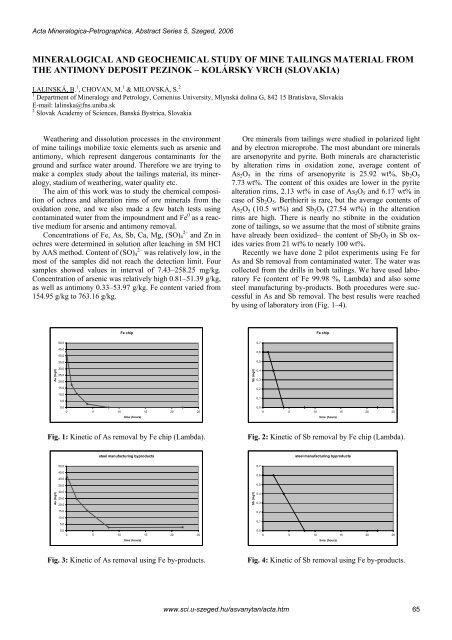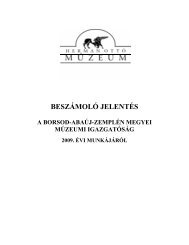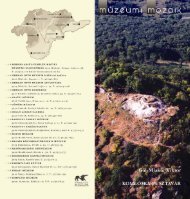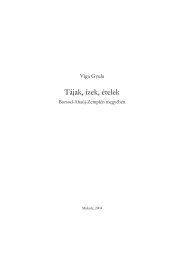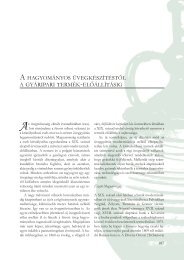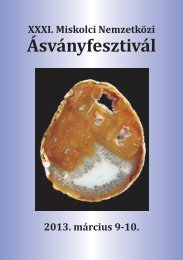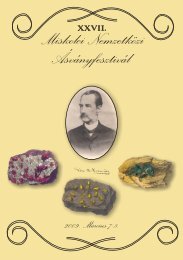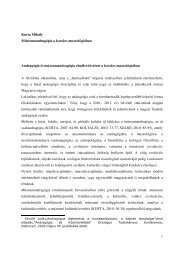Acta Mineralogica-Petrographica, Abstract Series 5, Szeged, 2006NATIVE GOLD OF <strong>THE</strong> UKRA<strong>IN</strong>IAN <strong>CARPATHIANS</strong>KVASNYTSYA, V.Institute of Geochemistry, Mineralogy and Ore Formation of NAS Ukraine, Palladin av. 34, 03680 Kyiv-142, UkraineE-mail: vmkvas@i.com.uaNative gold is a widespread mineral on the territory ofthe Ukrainian Carpathians. Many gold localities are knownin various structural-facial zones of the Carpathian Folds andTranscarpathian inner and the Precarpathian outer depressions(Table 1). In the Transcarpathians gold is related toNeogene volcanites while in the Carpathians to Proterozoic–Paleozoic metamorphosed rocks. Placer gold has been alsofound in Quaternary sediments (in alluvium of Bily Cheremosh,Chorny Cheremosh, Turya Remeta and Lyuchka rivers)of the following areas: Chyvchyny, Verkhovyna, Perechynand Yabluniv.In Ukrainian Carpathians, like in the other regions of theworld, with the transition of late deep-seated and mediumdeep-seatedmineralizations to younger shallower ones,gold’s fineness became lower, its heterogeneity higher; thecomposition and concentration of its admixtures changes; theproportion of idiomorphic crystals increases and their morphologybecomes more complex; equidimensional crystalsare replaced by modified ones; the role of dendrites and complextwin crystals increase. Minerals of gold also vary betweenelectrum, Au-rich silver (“küstelite”), Hg- and Cu-richgold.Table. 1: The characteristic features of native gold of the Ukrainian CarpathiansAreaDeposit, occurrence, structural-geologicalsettingMineral associationSize ofgrains,mmMorphologyLimits offineness(frequentvalues)Minorimpurities,0.0n–0.n %BeregoveMuzhieve deposit: Quartzsulphideveins and stockworksin Neogene acidic volcanosedimentaryrocksQuartz, galena, sphalerite,pyrite, alunite, barite,adularia, chalcopyrite,arsenopyrite, tetrahedrite,hematite0.1–1.0,rarely upto 10Dendrites, polyhedrons,xenomorphicandhypidiomorphicgrains500–880(600, 650,720, 760)Fe, Cu, Zn,Pb, As, Sb,Te, HgRakhivSaulyak deposit: Quartz andquartz-carbonate veins andveined-patched bodies inmetamorphosed quartzcarbonateand quartz-micachloriterocksQuartz, pyrite, pyrrhotite,chalcopyrite, galena,sphalerite, hessite, altaite,carbonates0.1–0.5,rarely upto 3Xenomorphicand hypidiomorphicgrains,rarely polyhedrons750–930(830, 860,910)Fe, Pb, As,HgChyvchynyBily Potik occurrence: Quartzveins and veined-patchedbodies in slaty quartzitesMarmarosh zone: CretaceousconglomeratesQuartz, pyrite, arsenopyrite,hematite, goethite,lepidocrociteQuartz, pyrite0.1–0.5,up to 30.1–0.8,up to 3Xenomorphicand hypidiomorphicgrains,rarely polyhedronsXenomorphicand hypidiomorphicgrains,slightly rounded780–950(880, 890,900, 910)840–995(930, 950)Fe, Cu, Pb,As, Sb, HgPb, Sb, HgNyzhniVorotaPaleogene flyschQuartz, pyrite0.1–0.5,up to 1Xenomorphicand hypidiomorphicgrains,slightly rounded790–960(910)Cu, Pb, AsYabluniv Miocene conglomerates Quartz0.1–0.5,up to 2.5Xenomorphicand hypidiomorphicgrains,slightly rounded920–980 Cu, Pb64www.sci.u-szeged.hu/asvanytan/acta.htm
Acta Mineralogica-Petrographica, Abstract Series 5, Szeged, 2006<strong>M<strong>IN</strong>ERAL</strong>OGICAL AND GEOCHEMICAL STUDY OF M<strong>IN</strong>E TAIL<strong>IN</strong>GS MATERIAL FROM<strong>THE</strong> ANTIMONY DEPOSIT PEZ<strong>IN</strong>OK – KOLÁRSKY VRCH (SLOVAKIA)LAL<strong>IN</strong>SKÁ, B. 1 , CHOVAN, M. 1 & MILOVSKÁ, S. 21 Department of Mineralogy and Petrology, Comenius University, Mlynská dolina G, 842 15 Bratislava, SlovakiaE-mail: lalinska@fns.uniba.sk2 Slovak Academy of Sciences, Banská Bystrica, SlovakiaWeathering and dissolution processes in the environmentof mine tailings mobilize toxic elements such as arsenic andantimony, which represent dangerous contaminants for theground and surface water around. Therefore we are trying tomake a complex study about the tailings material, its mineralogy,stadium of weathering, water quality etc.The aim of this work was to study the chemical compositionof ochres and alteration rims of ore minerals from theoxidation zone, and we also made a few batch tests usingcontaminated water from the impoundment and Fe 0 as a reactivemedium for arsenic and antimony removal.Concentrations of Fe, As, Sb, Ca, Mg, (SO) 4 2– and Zn inochres were determined in solution after leaching in 5M HClby AAS method. Content of (SO) 4 2– was relatively low, in themost of the samples did not reach the detection limit. Foursamples showed values in interval of 7.43–258.25 mg/kg.Concentration of arsenic was relatively high 0.81–51.39 g/kg,as well as antimony 0.33–53.97 g/kg. Fe content varied from154.95 g/kg to 763.16 g/kg.Ore minerals from tailings were studied in polarized lightand by electron microprobe. The most abundant ore mineralsare arsenopyrite and pyrite. Both minerals are characteristicby alteration rims in oxidation zone, average content ofAs 2 O 5 in the rims of arsenopyrite is 25.92 wt%, Sb 2 O 57.73 wt%. The content of this oxides are lower in the pyritealteration rims, 2.13 wt% in case of As 2 O 5 and 6.17 wt% incase of Sb 2 O 5 . Berthierit is rare, but the average contents ofAs 2 O 5 (10.5 wt%) and Sb 2 O 5 (27.54 wt%) in the alterationrims are high. There is nearly no stibnite in the oxidationzone of tailings, so we assume that the most of stibnite grainshave already been oxidized– the content of Sb 2 O 5 in Sb oxidesvaries from 21 wt% to nearly 100 wt%.Recently we have done 2 pilot experiments using Fe forAs and Sb removal from contaminated water. The water wascollected from the drills in both tailings. We have used laboratoryFe (content of Fe 99.98 %, Lambda) and also somesteel manufacturing by-products. Both procedures were successfulin As and Sb removal. The best results were reachedby using of laboratory iron (Fig. 1–4).Fe chipFe chip50,045,040,035,00,70,60,5As (mg/l)30,025,020,015,010,05,00,00 5 10 15 20 25time (hours)Sb (mg/l)0,40,30,20,10,00 5 10 15 20 25time (hours)Fig. 1: Kinetic of As removal by Fe chip (Lambda).Fig. 2: Kinetic of Sb removal by Fe chip (Lambda).steel manufacturing byproductssteel manufacturing byproducts50,045,040,035,00,70,60,5As (mg/l)30,025,020,015,010,05,00,00 5 10 15 20 25time (hours)Sb (mg/l)0,40,30,20,10,00 5 10 15 20 25time (hours)Fig. 3: Kinetic of As removal using Fe by-products.Fig. 4: Kinetic of Sb removal using Fe by-products.www.sci.u-szeged.hu/asvanytan/acta.htm 65
- Page 1:
MSCC33 rd MINERAL SCIENCES IN THE C
- Page 5 and 6:
Acta Mineralogica-Petrographica, Ab
- Page 7 and 8:
Acta Mineralogica-Petrographica, Ab
- Page 9 and 10:
Acta Mineralogica-Petrographica, Ab
- Page 11 and 12:
Acta Mineralogica-Petrographica, Ab
- Page 13 and 14: Acta Mineralogica-Petrographica, Ab
- Page 15 and 16: Acta Mineralogica-Petrographica, Ab
- Page 17 and 18: Acta Mineralogica-Petrographica, Ab
- Page 19 and 20: Acta Mineralogica-Petrographica, Ab
- Page 21 and 22: Acta Mineralogica-Petrographica, Ab
- Page 23 and 24: Acta Mineralogica-Petrographica, Ab
- Page 25 and 26: Acta Mineralogica-Petrographica, Ab
- Page 27 and 28: Acta Mineralogica-Petrographica, Ab
- Page 29 and 30: Acta Mineralogica-Petrographica, Ab
- Page 31 and 32: Acta Mineralogica-Petrographica, Ab
- Page 33 and 34: Acta Mineralogica-Petrographica, Ab
- Page 35 and 36: Acta Mineralogica-Petrographica, Ab
- Page 37 and 38: Acta Mineralogica-Petrographica, Ab
- Page 39 and 40: Acta Mineralogica-Petrographica, Ab
- Page 41 and 42: Acta Mineralogica-Petrographica, Ab
- Page 43 and 44: Acta Mineralogica-Petrographica, Ab
- Page 45 and 46: Acta Mineralogica-Petrographica, Ab
- Page 47 and 48: Acta Mineralogica-Petrographica, Ab
- Page 49 and 50: Acta Mineralogica-Petrographica, Ab
- Page 51 and 52: Acta Mineralogica-Petrographica, Ab
- Page 53 and 54: Acta Mineralogica-Petrographica, Ab
- Page 55 and 56: Acta Mineralogica-Petrographica, Ab
- Page 57 and 58: Acta Mineralogica-Petrographica, Ab
- Page 59 and 60: Acta Mineralogica-Petrographica, Ab
- Page 61 and 62: Acta Mineralogica-Petrographica, Ab
- Page 63: Acta Mineralogica-Petrographica, Ab
- Page 67 and 68: Acta Mineralogica-Petrographica, Ab
- Page 69 and 70: Acta Mineralogica-Petrographica, Ab
- Page 71 and 72: Acta Mineralogica-Petrographica, Ab
- Page 73 and 74: Acta Mineralogica-Petrographica, Ab
- Page 75 and 76: Acta Mineralogica-Petrographica, Ab
- Page 77 and 78: Acta Mineralogica-Petrographica, Ab
- Page 79 and 80: Acta Mineralogica-Petrographica, Ab
- Page 81 and 82: Acta Mineralogica-Petrographica, Ab
- Page 83 and 84: Acta Mineralogica-Petrographica, Ab
- Page 85 and 86: Acta Mineralogica-Petrographica, Ab
- Page 87 and 88: Acta Mineralogica-Petrographica, Ab
- Page 89 and 90: Acta Mineralogica-Petrographica, Ab
- Page 91 and 92: Acta Mineralogica-Petrographica, Ab
- Page 93 and 94: Acta Mineralogica-Petrographica, Ab
- Page 95 and 96: Acta Mineralogica-Petrographica, Ab
- Page 97 and 98: Acta Mineralogica-Petrographica, Ab
- Page 99 and 100: Acta Mineralogica-Petrographica, Ab
- Page 101 and 102: Acta Mineralogica-Petrographica, Ab
- Page 103 and 104: Acta Mineralogica-Petrographica, Ab
- Page 105 and 106: Acta Mineralogica-Petrographica, Ab
- Page 107 and 108: Acta Mineralogica-Petrographica, Ab
- Page 109 and 110: Acta Mineralogica-Petrographica, Ab
- Page 111 and 112: Acta Mineralogica-Petrographica, Ab
- Page 113 and 114: Acta Mineralogica-Petrographica, Ab
- Page 115 and 116:
Acta Mineralogica-Petrographica, Ab
- Page 117 and 118:
Acta Mineralogica-Petrographica, Ab
- Page 119 and 120:
Acta Mineralogica-Petrographica, Ab
- Page 121 and 122:
Acta Mineralogica-Petrographica, Ab
- Page 123 and 124:
Acta Mineralogica-Petrographica, Ab
- Page 125 and 126:
Acta Mineralogica-Petrographica, Ab
- Page 127 and 128:
Acta Mineralogica-Petrographica, Ab
- Page 129 and 130:
Acta Mineralogica-Petrographica, Ab
- Page 131 and 132:
Acta Mineralogica-Petrographica, Ab
- Page 133 and 134:
Acta Mineralogica-Petrographica, Ab


